The global C-RAN market size is accounted at USD 26.22 billion in 2025 and is forecasted to hit around USD 247.29 billion by 2034, representing a CAGR of 28.32% from 2025 to 2034. The Asia Pacific market size was estimated at USD 6.74 billion in 2024 and is expanding at a CAGR of 28.51% during the forecast period. The market sizing and forecasts are revenue-based (USD Million/Billion), with 2024 as the base year.
The global C-RAN market size was estimated at USD 20.43 billion in 2024 and is predicted to increase from USD 26.22 billion in 2025 to approximately USD 247.29 billion by 2034, expanding at a CAGR of 28.32% from 2025 to 2034. The demand for C-RAN is increasing due to the growth in networks like 5G, which boosts efficiency and allows users to work more efficiently. The rising demand for low-latency and high signal quality is influencing the market growth.
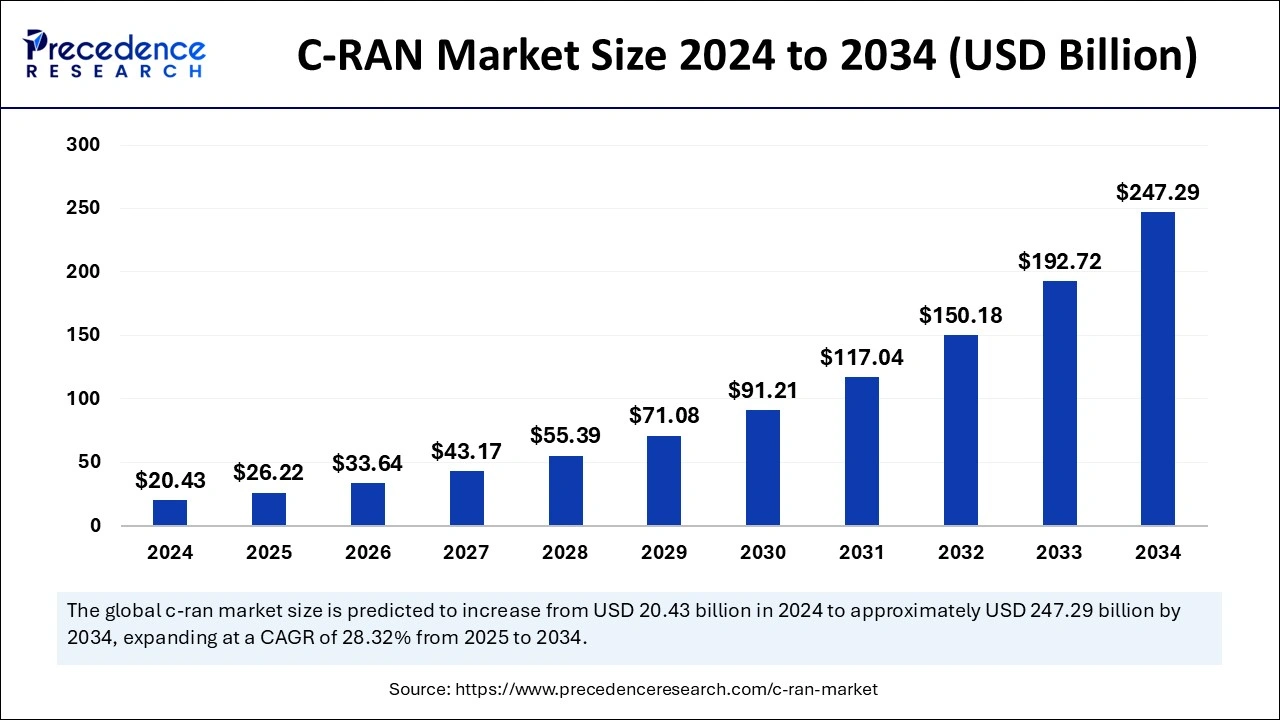
The emergence of technologies like artificial intelligence and machine learning (ML) is playing a transformative role in the networking industry. These technologies are significantly optimizing network resources by using real-time traffic patterns. AI-based tools are also gaining significant attention due to their capabilities in predictive analytics that enhance the network demand. AI also enhances automation through self-optimizing networks that can reduce the requirement for human intervention, making it profitable in the long run. Additionally, AI's role in managing real-time tasks is anticipated to play a vital role during complex situations like data traffic during peak times.
The Asia Pacific C-RAN market size was exhibited at USD 6.74 billion in 2024 and is projected to be worth around USD 82.84 billion by 2034, growing at a CAGR of 28.51% from 2025 to 2034.
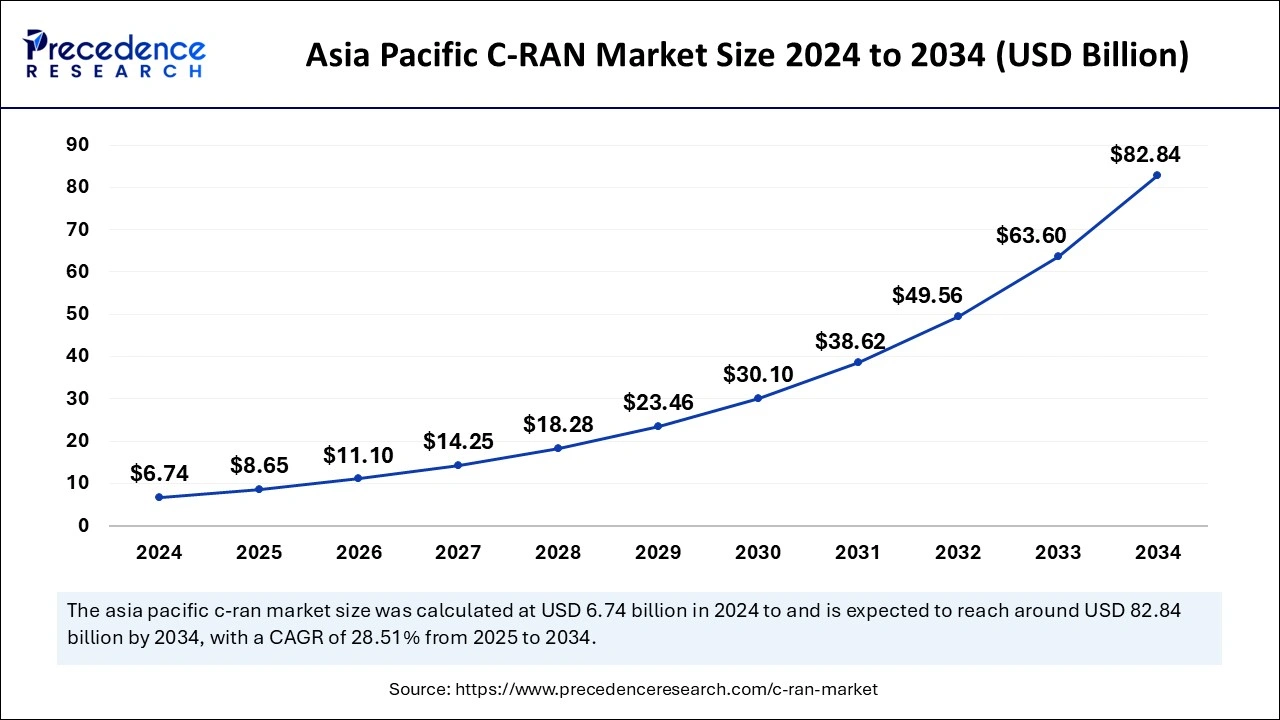
Asia Pacific dominated the C-RAN market by capturing the largest share in 2024. This is mainly due to the increased number of mobile users in countries like China, India, and Japan. With the increased proliferation of 5G networks, the need for advanced network infrastructure such as C-RAN has increased. The region also witnessed significant advancements in 5G infrastructure, bolstering the regional market growth.
India led the market in Asia Pacific and is expected to sustain its dominance in the coming years due to the growing emphasis on digitalization. With the growing industrialization, there is a heightened acceptance of cloud and Internet of Things (IoT) solutions, which significantly boosts market growth.
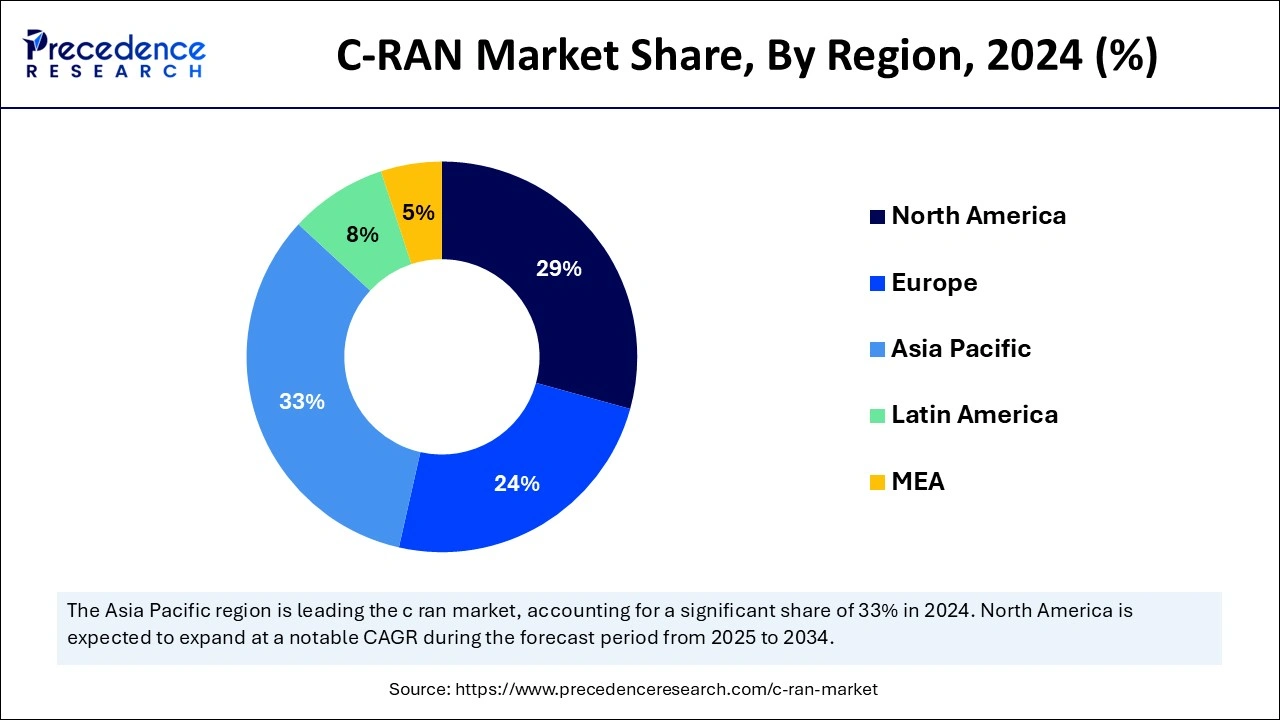
The market in North America is projected to expand at the highest CAGR throughout the forecast period. The regional market growth is attributed to the presence of advanced technologies in countries like the United States and Canada. The region boasts many leading telecom companies. This leads to heavy investments in deploying 5G infrastructures. Additionally, the telecommunication industry in the region is focusing on improving network performance by reducing operational costs and boosting the demand for C-RAN.
Centralized/Cloud Radio Access Network (C-RAN) is a modern cloud-computing-based architecture that vitally enhances and scales performance. The C-RAN market is growing rapidly due to the rising need to manage high data traffic in cities through centralization. The main components of the architecture are remote radio units, baseband processing units, and a fronthaul network, which play a major role in handling radio frequency transmission, performing signal processing, and maintaining the bandwidth within the network. The importance of C-RAN is increasing due to various benefits. It reduces the need for capital expenditure, uses the resources virtually, and also enhances the overall performance.
| Report Coverage | Details |
| Market Size by 2024 | USD 20.43 Billion |
| Market Size in 2025 | USD 26.22 Billion |
| Market Size in 2034 | USD 247.29 Billion |
| Market Growth Rate from 2025 to 2034 | CAGR of 28.32% |
| Dominating Region | Asia Pacific |
| Fastest Growing Region | India |
| Base Year | 2024 |
| Forecast Period | 2025 to 2034 |
| Segments Covered | Architect Type, Network Type, Component, Deployment, and Regions. |
| Regions Covered | North America, Europe, Asia-Pacific, Latin America, and Middle East & Africa |
Rising demand for 5G networks
The rapid digitalization in the developed regions has been playing a significant role in increasing the demand for 5G networks that fulfill the demand for a high-speed connection. The adoption of 5G is also leading towards automation in the automotive sector, where connectivity becomes crucial in autonomous vehicles. The overall demand for 5G in the corporate sector also becomes a crucial factor, as the companies are witnessing significant business opportunities for C-RAN.
Growth of cloud computing
The demand for cloud computing is significantly increasing due to its cost-effectiveness, which helps companies manage their expenses. This adoption eliminates the need for physical infrastructure and also provides the operation of network infrastructure with scalability. The C-RAN market is witnessing significant demand due to the growing virtualization of basebands that are replacing the hardware components and adapting software-driven systems. Small companies are also getting significant opportunities to help them adjust their operational costs. The C-RAN systems are anticipated to increase due to the growth across various industries.
Higher initial investments
The rapid digitalization in urban areas has significantly helped the growth of centralized networks. The deployment of these technologies uses advanced technologies, which are higher in cost and cannot be affordable in underdeveloped regions. The C-RAN market could face certain challenges due to the higher cost of hardware equipment that requires higher investments. Additionally, the transformation also raises the requirement for a skilled workforce, which can be a restraining factor as it adds to operational costs.
Rising demand in IoT and smart devices
The growth in technology has been playing a transformative role in network enhancement, fulfilling the requirements of connected devices. The C-RAN market is growing due to the rise of IoT networks, which are almost billions of dollars in value and include home appliances, sensors in various industries, etc. The architecture of C-RAN helps manage the resources of these smart devices. The rise of smart devices in various sectors like healthcare, automotive, and others has led to a demand for low latency, which has led to the growing demand for C-RAN.
Government focus towards digital transformation.
The rising technological advancements around the world are playing a transformative role in the adoption of digitization. Governments are heavily investing in 5G adoption to meet the requirements in developing economies that provide efficient services around different industries. The C-RAN market is growing rapidly due to the smart city initiatives that increase the need for enhanced connectivity. For instance, the Indian government approved a budget of INR 24 billion for the smart city projects to be executed in the year 2024-25. The growing initiatives are opening many business opportunities through public-private partnerships.
The centralized segment marked its dominance by registering the highest revenue share in 2024. The architecture includes the placement of BBUs at a central location, whereas the RRUs are distributed across various locations. The dominance of the segment is attributed to the well-established technology that manages the resources efficiently and provides services at lower costs. The C-RAN market is growing due to the rising network operations that have developed the need for simplified network management, especially during high data traffic.
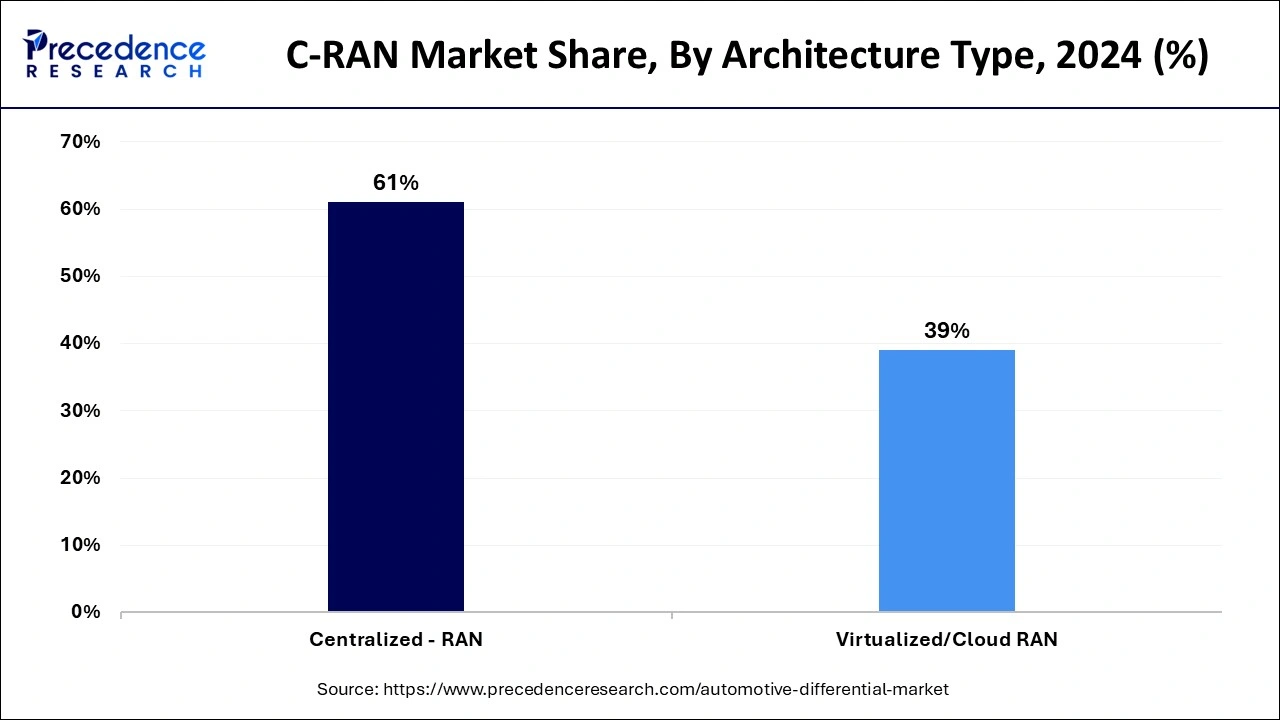
The virtualized/cloud-based segment is expected to grow at the highest CAGR during the forecast period of 2025 to 2034. The segment includes the replacement of hardware components with software-based solutions that can offer efficient services without the requirement for additional on-premise infrastructure. The C-RAN market grows efficiently due to the rising demand for flexible services that can be handled based on the traffic demand. The rising regulatory support from the governments is playing a vital role in the adoption of cloud solutions.
The LTE and 5G segment marked their dominance by contributing to the highest revenue share in 2024. The growth of the segment is attributed to the reliability of LTE, which has managed to provide high-speed connectivity over the past few years. The C-RAN market is experiencing significant demand due to the rising adoption of 5G networks in urban areas. The rise of global data traffic is one of the major factors that are driving significant investments in the adoption of centralized networks. Additionally, there is an increasing focus on infrastructure improvement.
The 3G segment is anticipated to grow notably during the forecast period of 2025 to 2034. The use of 3G remains prominent in the regions where 4G and 5G aren’t deployed, i.e., in underdeveloped regions. The low economy of these areas makes 3G a cost-effective solution for companies and individuals. The majority of the rural population resides in developing countries that are adopting these services to mark improvement in these regions.
The infrastructure segment stood dominant as it contributed to the highest revenue share in 2024. The infrastructure heavily relies on C-RAN systems due to the distribution of the networks. The C-RAN market is growing rapidly due to the increasing number of investments in the 5G network, which can fulfill the market demand. The demand also leads towards a rising focus on advanced hardware that is effective in performing in complex situations.
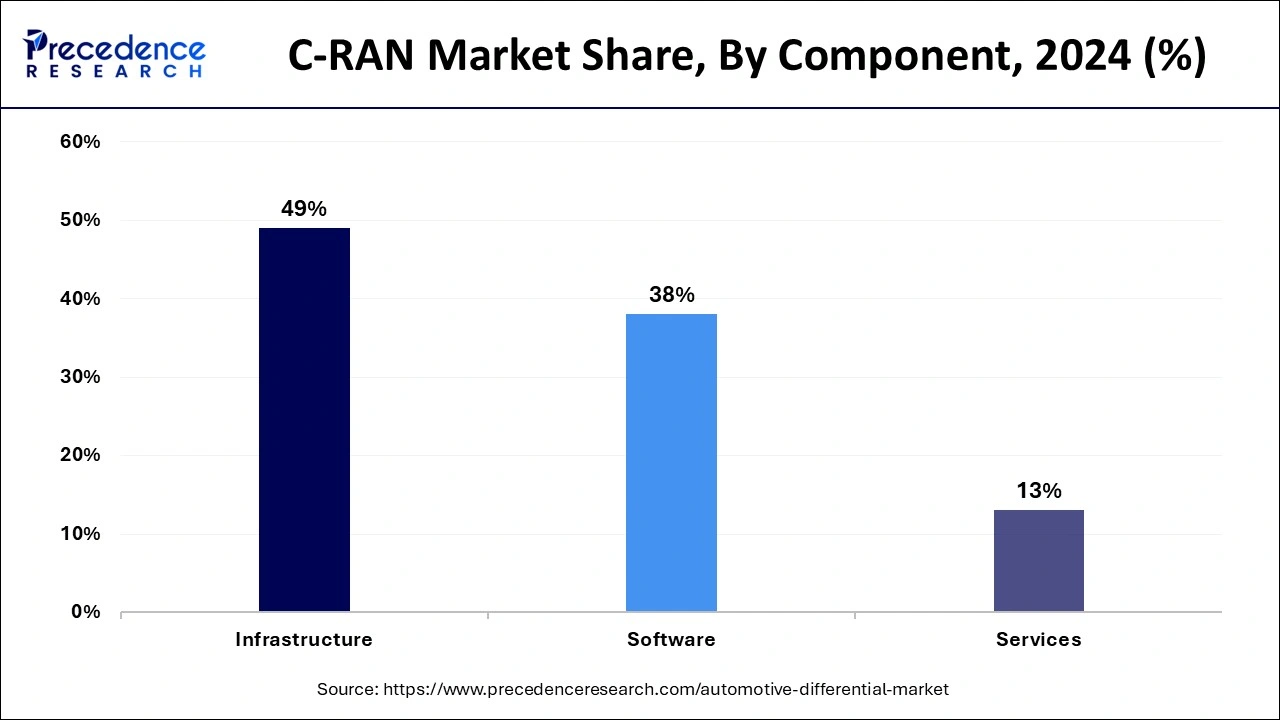
The services segment is anticipated to grow at the highest CAGR during the forecast period of 2025 to 2034. The segment deals with various aspects like designing, installation, and execution. The growth of personalized networks plays an important role in the implementation of these services due to the need for various preferences. The rising technologies are becoming crucial for managing services in the C-RAN market. Additionally, companies anticipate boosting these services for maintenance purposes.
The outdoor segment stood dominant as it generated the highest revenue share in 2024. The segment includes RRUs in outdoor locations like rooftops, towers, and many more that help provide a wider location. The C-RAN market is growing rapidly due to the rising need for enhanced networks in urban areas for various purposes like home appliances, industrial needs, and others. The demand for these architectures increases due to the rising need for connectivity in various weather conditions, which attracts significant investments.
The indoor segment is anticipated to grow at the highest CAGR during the forecast period of 2025 to 2034. The growth of the segment is attributed to the growing number of corporate offices, shopping malls, hospitals, etc. The demand for the C-RAN market increases due to the increasing number of users who need high-speed connectivity in these settings. Additionally, the rise of Augmented Reality and Virtual Reality is anticipated to raise the network standards in the upcoming years. The growth of the companies is leading to increasing initiatives toward security, which leads to the deployment of private networks to manage their operations.
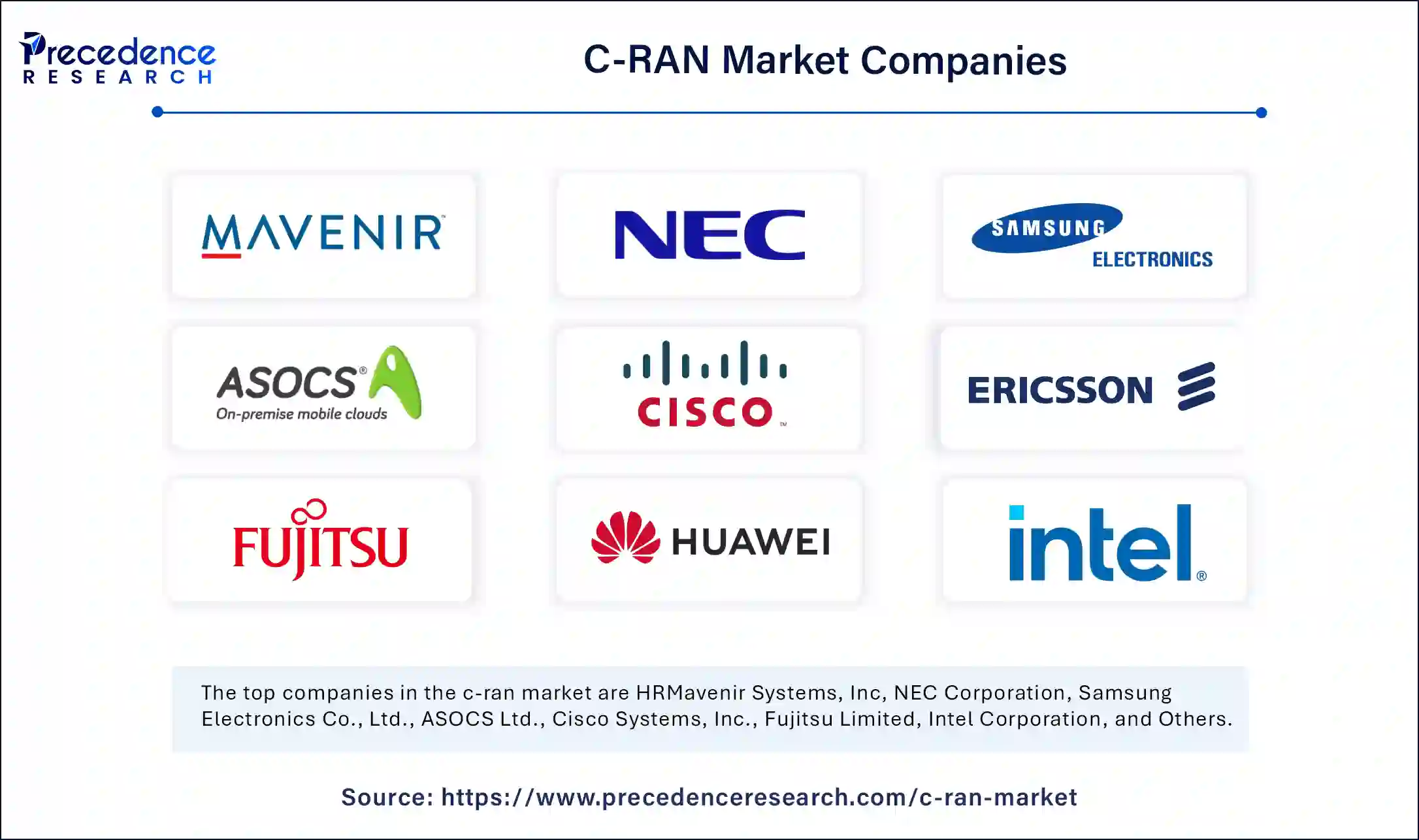
By Architecture Type
By Component
By Network Type
By Deployment
By Geography
For inquiries regarding discounts, bulk purchases, or customization requests, please contact us at sales@precedenceresearch.com
No cookie-cutter, only authentic analysis – take the 1st step to become a Precedence Research client